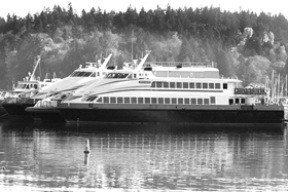Two passenger-only boats haven’t seen use since 2003, and sit tied up in Eagle Harbor.
If Puget Sound is Washington State Ferries’ home, then Eagle Harbor may well be that home’s coat closet.
That would explain the cobwebs gathered about the Chinook and Snohomish, two passenger-only ferries that have been shelved there throughout a series of foot ferry anchor-drags, including last month’s defeat of a proposed countywide sales tax increase that would have continued funding for service between Bremerton and Seattle.
“They’re just sitting in mothballs in Eagle Harbor,” said Sen. Phil Rockefeller, a Bainbridge Democrat, of the Chinook and Snohomish.
Rockefeller is sponsoring a bill that could simultaneously de-clutter the closet and help set foot ferries afloat between Kitsap County and Seattle, but only if a plan is developed quickly.
The bill is essentially an extension of one passed by lawmakers last year that would have placed proceeds from the sale of the two boats – which haven’t seen action since 2003 – into an account dedicated to funding foot ferry service.
Under the original plan, either Kitsap or King county had to submit to the governor by last fall a business plan detailing how any such service would be run in order to access the money.
Neither county did, and the deadline passed. The vessels weren’t sold. Then Kitsap Transit’s tax initiative failed, further dampening the prospects for foot ferry service that was abandoned by the state a few years ago and has since floundered in private hands.
This year’s version of the bill cleared the Senate by a healthy margin last week and is now making its way through the House. It requires that the vessels be made available for sale at market value by June 1. Together the boats are worth between $8 million and $9 million, said WSF Planning Director Ray Deardorf, all of which would go to fund future foot ferry service.
Though there has been no discussion of a passenger-only route that would serve the island, proponents have argued that better service elsewhere would alleviate some of the burden on WSF’s Seattle-Bainbridge run, the system’s busiest.
Past ridership projections – the subject of scrutiny following a recent ferry financing study – had indicated that the busiest Bainbridge commuter runs could be filled to capacity in less than a decade.
“By 2015, at the ‘peak of the peak’ period there will be at least one sailing on the Seattle-Bainbridge route that exceeds available passenger capacity,” it says in WSF’s ten-year passenger strategy plan, published in 2005.
That plan assumes the existence of at least a Kingston-Seattle passenger run – which has since failed – and possibly other passenger-only routes to help carry the load.
Now Kitsap Ferry Company, which operates Kitsap Transit-subsidized passenger service between Bremerton and Seattle, has filed with the Washington Utilities and Transportation Commission to suspend service for a year while new funding options are explored. Without subsidies from Kitsap Transit, islander and Kitsap Ferry Company President Greg Dronkert said the company can’t continue to operate.
If its request to the UTC is granted and funding is found, the service could return in a year, either on the Bremerton run or between Kingston and Seattle. If the request is denied, the company could lose its commercial ferry permit and would no longer be allowed to operate between Bremerton and Seattle. The decision is expected on March 28. The company’s last day of service will be March 30.
“We’re not prepared to let the naysayers declare victory,” Dronkert said. “The biggest challenge is in the operating costs. Any operating model needs reliable funding.”
Dronkert said he hopes that funding comes courtesy of the Chinook and Snohomish. But even if the legislation passes, the money wouldn’t be made available without the submittal of a plan to the governor and the Legislature by November 1.
Kitsap Transit Director Dick Hayes said that despite the failure of two foot ferry measures in the past four years, he believes a public-private partnership is a viable way to provide service.
“I think we proved that the model works,” said Hayes, who like Dronkert remains excited about low-wake vessel research that has been ongoing. “We don’t want to throw all that away.”
Kitsap Transit has invested some $3.8 million in mostly federal money on passenger-only ferry service. The company spent $250,000 in direct support of Kitsap Ferry Company during its 31 months of Bremerton-Seattle service, and $110,000 on a mitigation fee for a capital project in Kingston.
The rest of the money went to fund larger, faster low-wake vessels that could more quickly bridge the gap between Kitsap County and Seattle without damaging shorelines or upsetting neighbors. Both Hayes and Dronkert said the research – which is about 80 percent complete – has been successful thus far, and has national and even international implications because companies elsewhere are interested in the technology.
But, Dronkert said, better service would require better funding, and a second boat to fulfill demand.
“The time is just not right at this moment,” he said, referring to the nearly 55 percent of Kitsap County residents who voted against last month’s foot ferry measure. “But I think there are a whole lot more people out there who wanted the service. They just didn’t want to pay for it.”
Hayes said he doesn’t think another election is the answer, but agreed with Dronkert about the desire for service on the part of county residents.
“Somebody needs to do this somehow,” he said.
Rockefeller concurred, but said his optimism is measured.
“The door is open if this bill passes,” he said. “The question is ‘What’s the viable plan for the long-term.’
“If Dick Hayes can’t bring any resources to the table, I doubt the governor is going to make an investment in something that’s likely to fail.”



